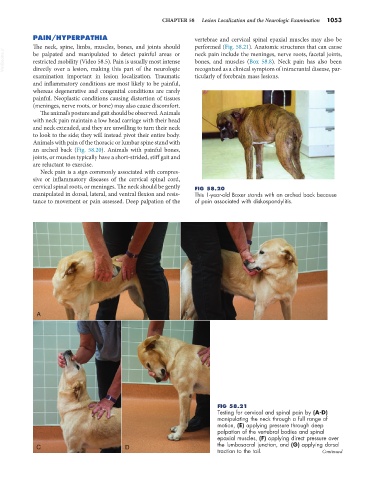Page 1081 - Small Animal Internal Medicine, 6th Edition
P. 1081
CHAPTER 58 Lesion Localization and the Neurologic Examination 1053
PAIN/HYPERPATHIA vertebrae and cervical spinal epaxial muscles may also be
The neck, spine, limbs, muscles, bones, and joints should performed (Fig. 58.21). Anatomic structures that can cause
VetBooks.ir be palpated and manipulated to detect painful areas or neck pain include the meninges, nerve roots, facetal joints,
bones, and muscles (Box 58.8). Neck pain has also been
restricted mobility (Video 58.5). Pain is usually most intense
directly over a lesion, making this part of the neurologic
ticularly of forebrain mass lesions.
examination important in lesion localization. Traumatic recognized as a clinical symptom of intracranial disease, par-
and inflammatory conditions are most likely to be painful,
whereas degenerative and congenital conditions are rarely
painful. Neoplastic conditions causing distortion of tissues
(meninges, nerve roots, or bone) may also cause discomfort.
The animal’s posture and gait should be observed. Animals
with neck pain maintain a low head carriage with their head
and neck extended, and they are unwilling to turn their neck
to look to the side; they will instead pivot their entire body.
Animals with pain of the thoracic or lumbar spine stand with
an arched back (Fig. 58.20). Animals with painful bones,
joints, or muscles typically have a short-strided, stiff gait and
are reluctant to exercise.
Neck pain is a sign commonly associated with compres-
sive or inflammatory diseases of the cervical spinal cord,
cervical spinal roots, or meninges. The neck should be gently FIG 58.20
manipulated in dorsal, lateral, and ventral flexion and resis- This 1-year-old Boxer stands with an arched back because
tance to movement or pain assessed. Deep palpation of the of pain associated with diskospondylitis.
A B
FIG 58.21
Testing for cervical and spinal pain by (A-D)
manipulating the neck through a full range of
motion, (E) applying pressure through deep
palpation of the vertebral bodies and spinal
epaxial muscles, (F) applying direct pressure over
C D the lumbosacral junction, and (G) applying dorsal
traction to the tail. Continued

